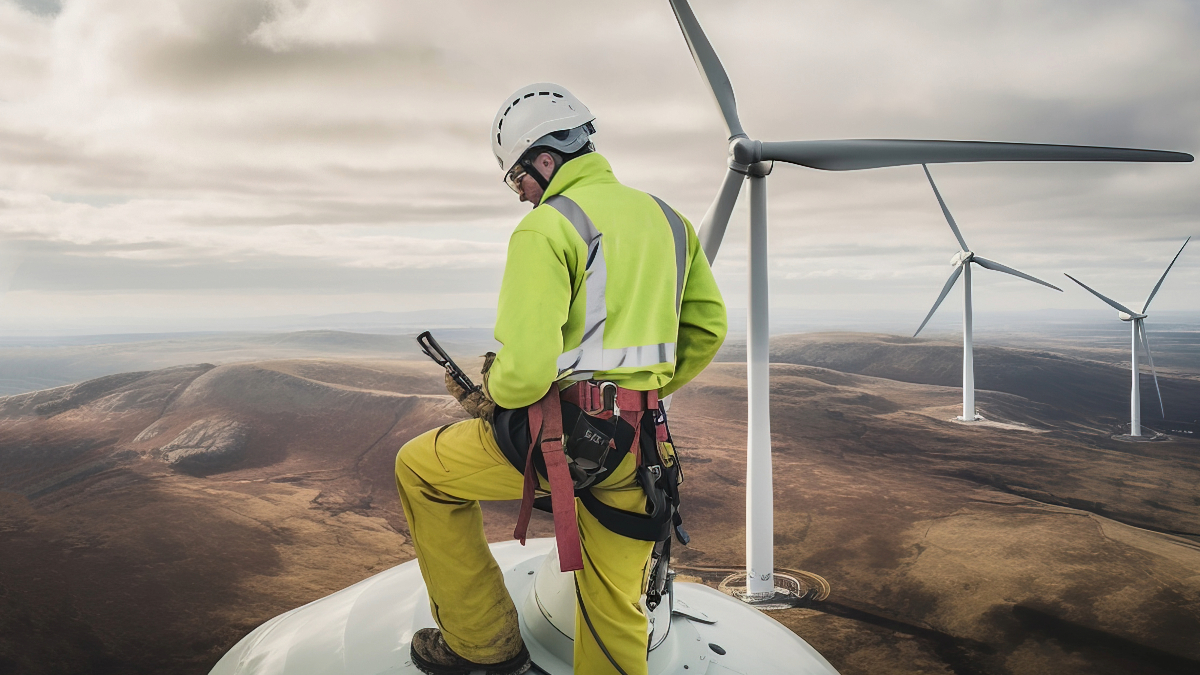Wind power is a key green technology that will help renewable energy replace fossil fuels and end the Climate Crisis. Wind turbines, or as you might call them, windmills, have been used for almost 1,200 years.
From powering sawmills to pumping water and grinding grain, wind power has been a key to human development. Today, wind energy produces 10% of the electricity in the United States and 20% more electricity than solar panels globally. In Iowa, wind accounts for 19.7% of the electricity used in the state. Because wind can blow all night, wind turbines are an important source of reliable power in the mix of renewable sources, including solar, hydroelectric, and geothermal energy.
The first ideas about building windmills dates back to Babylon, almost 3,700 years ago, but they first appeared in the 8th and 9th centuries in Middle East and then spread to China and Europe. The famous Dutch windmills were adapted from Muslim designs to help pump water to create dry land in The Netherlands, where almost 27% of the country lies below sea level.
Wind has been harnessed to produce electricity since 1887, when James Blyth of Anderson’s College in Scotland developed a simple wind turbine that he used to power his cottage! Unfortunately, his offer to the nearby village to power their homes with the excess electricity was rejected. People called it “the work of the devil.” But his next windmill found a home at the Montrose Lunatic Asylum, where the electricity powered the hospital that is known as Sunnyside Royal Hospital today.

How Wind Turbines Work
Turbines collect power as the blades are pushed by the wind and turn a drive shaft, one end of which runs through a generator made of insulated coils of wire. As the drive shaft turns inside an electric generator, electricity is produced and can be used to power a home, a city, or an electric vehicle.
Electric generator technology was invented by Michael Faraday in 1831. He realized that magnets spinning in an insulated tube wrapped in copper wires would produce excited electrons, electricity, that he could capture, transfer and use as energy. Once Faraday’s breakthrough was known — and it was widely celebrated as one of the greatest inventions in history — it was just a matter of time before the lightbulb and electric utilities were introduced over the next 50 years.
James Blyth was the first to use wind to drive an electric generator. Poul la Cour, a Danish scientist, was the next scientist to discover a way to improve the efficiency of wind power. In the 1890s, la Cour ran tests on windmills in an attempt to power rural Denmark and discovered that fewer blades with faster rotation was the best recipe to generate electricity. In 1903, he founded the Society of Wind Electricians, and by 1904 the society met for the first time to teach people the principles of wind energy.
From Invention to World-Changing Technology


Twenty-three years later, two Americans, Joe and Marcellus Jacobs opened a factory in Minnesota to produce wind turbines. They sold their wind turbines to farmers. At that time, the electric grid was not well established and most farms had no electricity.
In 1931, George Darrieus, a French inventor, patented the “eggbeater windmill,” which is the design we still see today that uses several blades wrapped around the drive shaft. That same year, Yalta, a city that is now part of Ukraine but at the time part of the Soviet Union, introduced using a very efficient horizontal wind generator. The Yalta generator produced 100kW, about the power needed to run one modern home for an hour. But because it captured 32% of the wind’s potential energy, this wind turbine is still pretty good by today’s standards — by contrast, solar panels capture between 18% and 24% of the sun’s potential energy.
When you think of turbines, you probably think of megawatt turbines, the giant white windmills dot landscapes in many states and countries.
Big Turbines To Power Cities
The first megawatt (mW) turbine, which could power 1,000 modern homes for an hour, was built in Castleton, Vermont, in 1945. This turbine had massive, 75-foot-long blades. Each blade weighed 250 pounds, but when the wind moved them they generated far more electricity than lighter blades.
Then came a former student of Poul la Cour, Johannes Juul, who designed a 200-foot-tall turbine in Gesder, Denmark, in 1956. The Gesder turbine, which is the model for today’s biggest It ran until 1967 and then was refurbished when the U.S. National Aeronautics and Space Administration (NASA), asked that it be turned back on to support its research into wind power.
NASA erected 13 experimental turbines in Ohio and by 1980 the world’s first wind farm with 20 turbines was completed in New Hampshire. However, the wind farm project failed for two reasons, NASA overestimated its generation capacity, so it looked like wind could not match the promised power, and the turbines broke down very quickly. But that didn’t stop NASA, which learns from its failures.

Applying the lessons of the New Hampshire project, NASA developed the 7.5 mW Mod-2 turbine in 1981 and and then in 1987 the 3.2mW Mod-5B turbines. Both of the new designs break records for both diameter and energy output. These designs laid the groundwork for today’s modern wind power industry. Now, it was a matter of finding good locations for wind farms and connecting them to the electric grid so that the power could be moved to homes and businesses that would buy it.
Ten years later in Denmark, the first offshore wind farm was built and the same year, in Delabole, Cornwall, England, an onshore wind farm generated enough power for 2,700 homes with just ten turbines.
By 2003, the UK introduced its first offshore wind farm with 30 large turbines installed in the sea along the coast of Wales. British leaders got excited about the prospects for wind power and announced they could power the whole country using wind by 2020. This did not come to pass, though; in 2020, the British government did announce they reached a tipping point where renewable energy outperformed fossil-fuel energy sources at a lower cost.
The United States has invested in wind energy, too. Wind turbine generation capacity is growing by an average of 7% per year, and many power companies are investing in a wind-powered future. The US Department of Energy reported in 2023 that 10% of electricity generated in the U.S. came from wind, enough to power 43 million homes year-round.
This also means that there will be plenty of jobs in the wind sector. From engineers and scientists who design new wind energy technology to machinists, welders, and inspectors who build and maintain turbines, there are jobs for every type of person in the wind power industry. There might even be a job for you.





